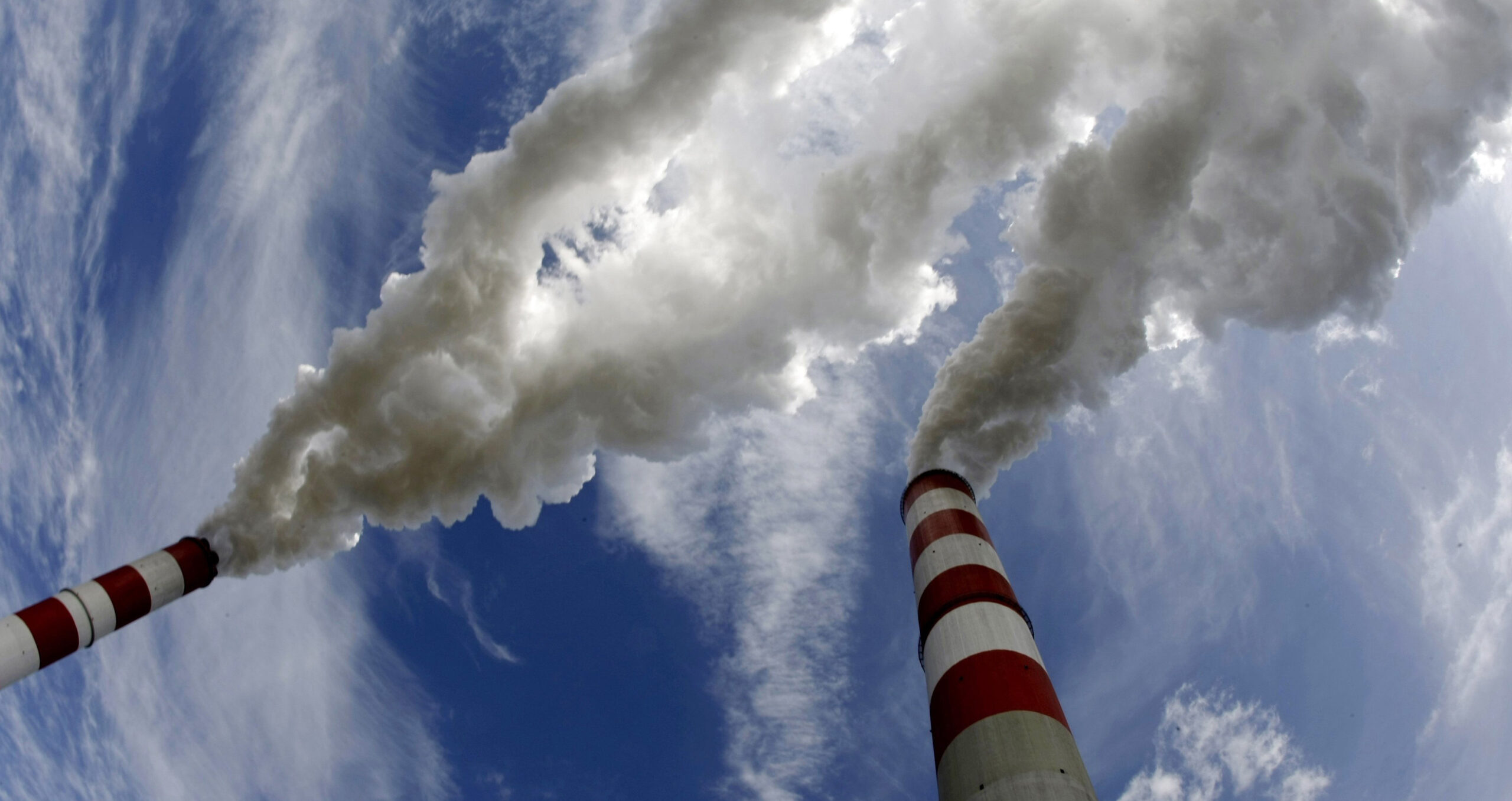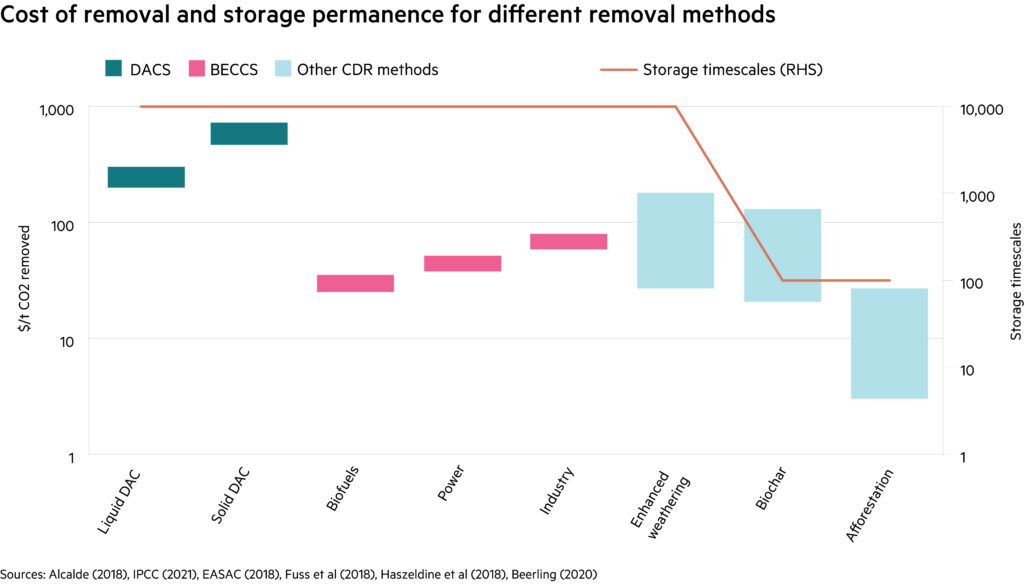

Supporters insist removing carbon from the atmosphere is necessary to reach net zero, but critics call it a ‘dirty trick’ from fossil fuel producers
Carbon geoengineering is the removal and durable storage of carbon emissions from the atmosphere aimed at helping to limit the global temperature rise. While carbon dioxide removal technologies could support efforts to reach net zero emissions by 2050, they remain controversial and critics warn that fossil fuel producers could use them to justify business as usual.
All Intergovernmental Panel on Climate Change net zero model pathways include the removal of CO2 from the atmosphere to reach net zero emissions. By 2050, the IPCC estimates around 9bn tonnes of CO2 will need to be removed from the atmosphere every year if global warming is to be held at 1.5C above pre-industrial levels. Of this, 6bn tonnes of CO2 a year will be removed through nature management, including afforestation and reforestation, and approximately 3bn tonnes through solutions such as direct air capture and bioenergy with carbon capture and storage, it says.
Annual carbon emissions from power generation and industry reached 36.8bn tonnes in 2022, increasing from 36.5bn tonnes in 2021, the International Energy Agency estimates, making the IPCC’s proposed 9bn tonnes in annual CDR around a quarter of current annual energy and industry emissions.
Today, about 2 gigatonnes of CO2 a year are removed, almost all by natural sinks like forest land and marine ecosystems, Sylvain Delerce, associate research director at CDR think-tank Carbon Gap, tells Sustainable Views. “That’s far from sufficient to stay on track for 1.5C,” he says, insisting that “the share of permanent carbon removal” also needs to increase “if we are to meet net zero by 2050” and stick to it.
Removal or geoengineering?
Geoengineering is an overarching term covering two categories: carbon geoengineering and solar geoengineering.
Solar geoengineering is a largely theoretical practice, involving the reflection of sunlight away from the earth to reduce its temperature. “A lack of scientific understanding and of governance increases the possibility of premature and ill-considered deployment of [solar geoengineering] technologies,” the Climate Overshoot Commission said in a report published in September.
Solar geoengineering could be “prone to unilateral action, which would be problematic”, says Delerce, while this is “not the case for carbon removal”. Given these concerns, the CDR community “has departed from using the word ‘geoengineering’ because it tends to create a lot of amalgam and misunderstandings”, he adds.
Nonetheless, the term is a major topic of debate.
At COP28, leaders discussed “climate intervention strategies” including geoengineering, and ahead of the climate conference Unesco published a report warning of the risks of relying on geoengineering, such as CDR and solar radiation modification, to slow down global temperature rise.
Carbon geoengineering, meanwhile, has similar goals to carbon capture utilisation and storage, but while CCUS captures emissions on site in high-polluting industries like fossil fuel power plants, carbon geoengineering seeks to remove CO2 from the atmosphere and can be deployed across locations.
Alternative methods
Bioenergy with carbon capture and storage involves capturing and permanently storing CO2 produced during the process of turning biomass into fuels — plants absorb CO2 as they grow and the amount they store is considered as removed from the atmosphere.
Around 2 megatonnes of CO2 from biomass are captured a year, mainly in bioethanol applications, the IEA says. In its net zero emissions scenario, the IEA says 190 megatonnes of CO2 should be removed through BECCS by 2030, but the agency’s projections based on planned facilities show that, in reality, just under 50 megatonnes of CO2 a year will be removed by 2030.
UK power company Drax has transitioned from burning coal to generating electricity from biomass in the form of wood pellets forested in the US and Canada. Drax says the resulting electricity is “renewable” and “sustainable” and is trialling BECCS at its power plant in North Yorkshire. However, the company has faced significant criticism from environmentalists and in May 2023, the UK energy regulator launched a formal investigation after a BBC probe accused Drax of using unsustainably sourced wood.
Research from environmental law charity ClientEarth suggests Drax’s biomass burning produces higher levels of CO2 than coal. These combustion emissions are, however, counted as “zero” under international carbon accounting principles and under EU and UK law on the basis that any deforestation should be counted elsewhere, at the forest level.
“Drax’s claim that wood biomass — which made up 75 per cent of its electricity generation in 2020 — can be considered a ‘zero’ or even low-carbon source of energy, like wind or solar energy, is widely disputed,” says ClientEarth.
Direct air capture, meanwhile, is the process of removing CO2 from the atmosphere and converting it into a liquid to be stored underground by injecting it into porous rock formations. The IEA says 27 DAC plants have been commissioned to date worldwide, but current capture capacity from DAC is a mere 0.01 megatonnes of CO2 a year.
Plans for at least 130 DAC facilities are at various stages of development, meaning it is theoretically possible to reach the level required in 2030 under the net zero emissions by 2050 scenario, capturing around 75 megatonnes of CO2 a year, the IEA says. However, some projects are at “a very early stage, with no funding committed and, in certain cases, not even an identified location for deployment”, the agency adds.
Further, despite government support and private investment, DAC remains hugely expensive, as critics point out. The technology costs between $125 and $335 a tonne of CO2 for a large-scale plant built today, IEA predictions show. The World Resources Institute puts this figure as high as $600 a tonne.
“Direct air capture is a waste of taxpayers money that serves to save the fossil fuel industry, not people or the planet. Instead of funnelling money into unproven solutions, public money should be invested into proven ones, like energy efficiency and renewable technologies,’’ Sarah Biermann Becker, senior investigator at non-profit Global Witness, tells Sustainable Views.
An alternative form of CDR is biochar, a charcoal-like substance made by burning biomass in the absence of oxygen. The resulting biochar can be used as an additive for soil, building materials or animal feed. Since the CO2 from the biomass is stabilised in the biochar, the process is considered carbon negative.
The production of biochar can be funded through the voluntary carbon market, suggests Jörg zu Dohna, chief executive of biochar technology company Pyreg. “[Biochar offers] high-value carbon credits because they are measurable and verifiable”, and data can be taken from the machines and shared with a third party, he tells Sustainable Views. “91 per cent of the credits in the voluntary carbon market that were generated in the first half of 2023 came from biochar carbon removal,” zu Dohna adds, referencing data from CDR.fyi.
A report published by the World Economic Forum in January 2024 says “private sector leaders” have an “important role to play” in scaling up financing for new methods of carbon removal. The report commends the WEF-led First Movers Coalition of private companies which has committed to either contract solutions capable of removing 50,000 tonnes of carbon or solutions worth an estimated $25mn by 2030. The solutions can be technological, like DAC or BECCS, or natural, like tree planting, but they “must minimise environmental [and social] harm,” says the report.
Afforestation, soil sequestration, peatland and wetland restoration and other measures to restore natural carbon sinks are considered forms of “organic” CDR or carbon geoengineering. There is a higher chance of CO2 re-entering the atmosphere from these solutions; for example, if forests are cut down or damaged, Carbon Gap says, but they do not require complex infrastructure. Much like biochar, these methods are often financed through the carbon market.

DAC leads funding charts
Research by Carbon Gap found that global investment in new CO2 capacity totalled approximately $200mn between 2020 and 2022. The vast majority of announced purchases focus on DAC, with biochar the next most prominent method.
“Proposed DAC demonstration hubs in the US account for the vast majority of traceable public funding ($3.5bn) [between 2010 and 2022],” Carbon Gap says. In 2022, the US Department of Energy announced $3.5bn in funding under the Bipartisan Infrastructure Law’s programme to develop “regional direct air capture hubs”.
“Global carbon dioxide removal patenting activity has increased over the last 15 years, with a large and growing share occurring in China. In 2018 – the last year of complete data – China accounted for 36 per cent of all carbon dioxide removal patents,” Carbon Gap adds.
In 2021, the Australian government funded a A$4mn ($2.7mn) direct air capture and storage demonstration project. The UK government also ran its first greenhouse gas removal development programme from 2017 to 2021, funding 11 projects totalling £8.6mn. The UK’s net zero strategy, published in 2021, granted £250,000 to 23 projects (a total of £5.9mn) focusing on the design and feasibility of CDR. An additional £58mn will be awarded to pilot the 15 most promising designs by March 2025.
In the EU, funding for CDR is offered through the Innovation Fund, which announced funding for a BECCS project worth €180mn in 2022, and Horizon Europe. Carbon Gap estimates that funding from Horizon Europe will equal €185mn for activities both directly and indirectly related to CDR (34 projects) and €161mn for projects directly related to CDR (28 projects).
The Climate Overshoot Commission recommends that governments incentivise CDR from the atmosphere through tax credits, for example. The US government offers subsidies of $85 a tonne for CO2 permanently stored and $60 a tonne for CO2 used for enhanced oil recovery or other industrial uses under the Inflation Reduction Act — the credit applies to both CDR and carbon capture and storage.
‘Get-out-of-jail-free’ card
One of the major criticisms levelled at the CDR sector is that it removes attention from the underlying problem of needing to quickly and significantly reduce emissions. As Becker says: “The best way to reduce carbon emissions is to stop producing them in the first place.
“Organic and inorganic ways of storing carbon are different and should be considered differently — storing carbon underground doesn’t work, whereas afforestation can work if done right — but if they’re being used by oil companies to justify production, they amount to the same dirty accounting trick,” she adds.
Carbon Gap’s Delerce acknowledges the risk of mitigation deterrence, but for him it is the responsibility of regulators to ensure that CDR targets are separated from emissions reduction targets and to ensure different funding streams. “It is a risk, but let’s stop complaining about it. Let’s do something about it,” he says. “It is still the case that we need [CDR] as per IPCC conclusions.”
But Becker insists that: “Ultimately, carbon removal technologies are much more likely to safeguard the future of the fossil fuel industry than to safeguard humanity. They’re being used as a get-out-of-jail-free card to drill for more fossil fuels and to divert attention from scaling real solutions.”
Similar Articles

In Charts: Capacity constraints and lack of awareness limit Chinese green municipal bond issuance

In Charts: Europe must choose between Chinese EV imports or its emissions targets, says ECA


